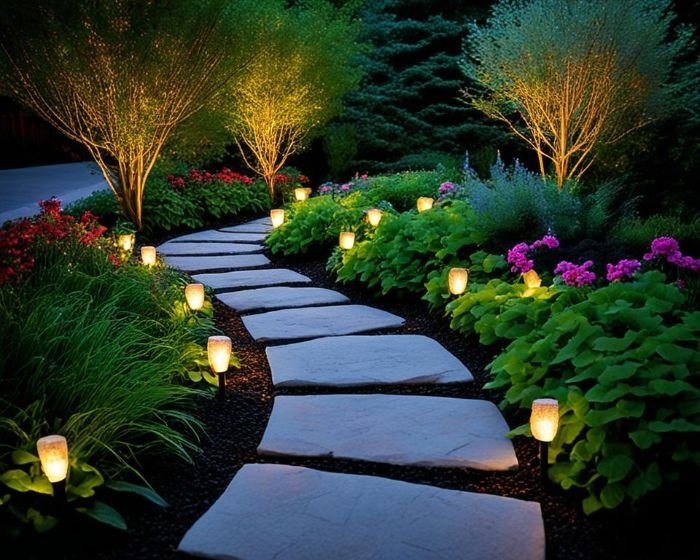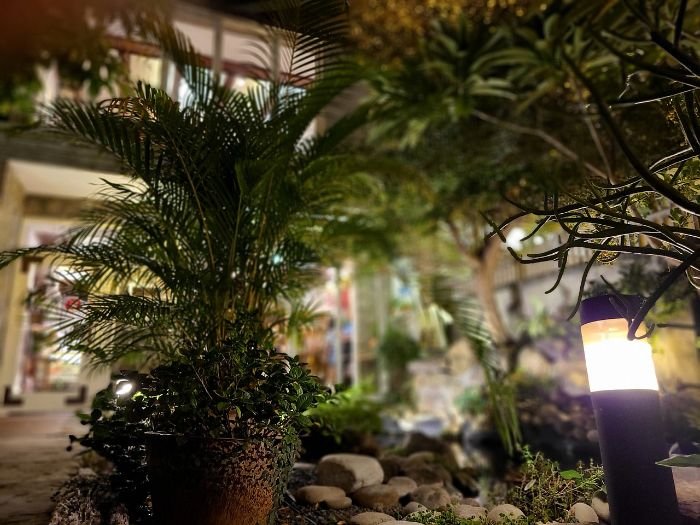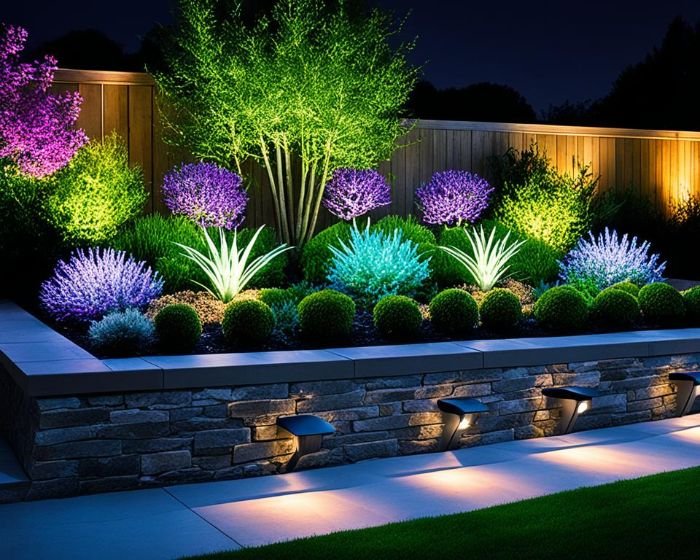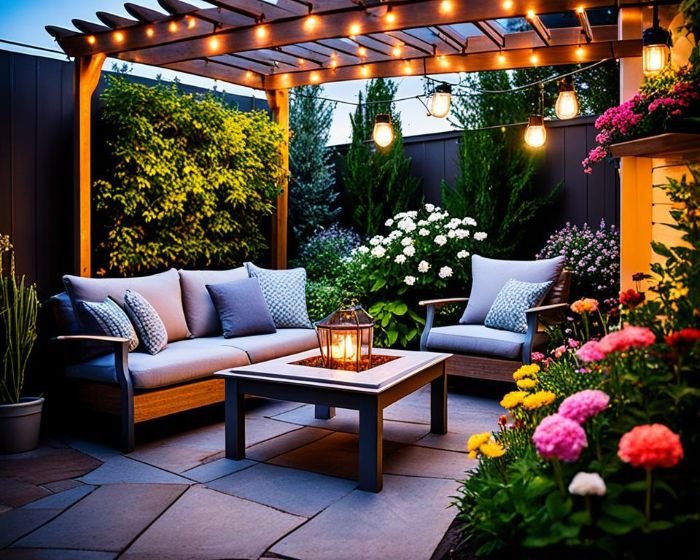Dreaming of turning your garden into a magical place at night? Want to add beauty and safety? Garden lighting is your answer. It makes your outdoor space shine and more useful. This guide is here to help you get started.
We’ll cover the basics, such as why garden lighting matters and how to pick the right lights. You’ll learn about pathway lights, spotlights, and more. We’ll also talk about solar and electric options. Plus, discover design tips and safety info. And how to use lights to make your garden look even better.
Ready to see your garden come alive at night? Let’s start with the essentials of garden lighting. See how it changes your outdoor area!
Key Takeaways:
- Garden lighting can transform your outdoor space into a beautiful and functional nighttime oasis.
- Understanding the importance of garden lighting is crucial for creating an inviting and safe environment.
- Choosing the right lights for your garden involves considering factors such as power source, budget, and lighting design.
- Proper installation and maintenance are essential for ensuring the longevity and functionality of your garden lights.
- With the right techniques and fixtures, you can enhance specific garden features and create stunning visual effects.
Table of Contents
About Garden Lighting
Garden lighting does more than light up your yard. It turns your space into a magical place. With lights placed thoughtfully, you make your area warm and inviting. Not only does it look nice, but it also adds safety and extends your outdoor fun into the night. It doesn’t matter if your space is big or small. Good garden lighting makes it both beautiful and useful.
Why Garden Lighting Is Important
Garden lighting makes your outdoor area shine. It adds a touch of elegance and charm. Bright lights can show off your home’s design and the greenery in your garden. Plus, it keeps your home safe. With paths and doorways well-lit, you reduce accidents and scare off bad guys.
Also, it means you can use your yard at night. Your patio or garden becomes the perfect spot for a meal or to read. The right lights set a cool mood.
Last but not least, lights let you show off your garden’s best parts. Maybe a cool statue or a pretty plant. There are so many ways to light up these features. It makes your garden look amazing and unique.
Key Considerations Before Installing Garden Lights
Thinking of adding lights to your garden? First, work out your budget. Lighting can be simple or fancy. Decide how much you want to spend.
Next, think about how to power your lights. You can pick solar lights or electric ones. The best choice depends on your garden’s sunlight and your energy plan.
Choosing the right type of light is also crucial. Do you want lights for your paths or for a special tree? Pick based on what you want to light up and check how much they need to be taken care of.
Remember, garden lights need to be looked after. You’ll have to clean them, change bulbs, and maybe fix them. Keep this in mind when picking out your lights.
Now, you’re ready to start planning. Whether you go for simple or bright lights, they’ll make your garden better. Start imagining how great your space will look with the right lights.
Types of Garden Lighting
When talking about garden lighting, you have many choices. Each one fits different needs and styles. Learning about the types can help set the right feel and use for your garden. We will look at pathway lights, spotlighting, and task lighting.
Pathway Lights for Safety and Beauty
Pathway lights are key for a well-lit garden. They mix practical use with looks, making paths safer and prettier. These lights stay near the ground to light the walkways, helping everyone move safely at night.

These lights come in many looks, like lanterns or bollards. You can get them in stainless steel or other materials to fit your garden’s style. Placing them right is important. Make sure to space them equally and in a line for a nice look.
Spotlighting and Task Lighting for Functionality
Spotlights and task lighting highlight parts of your garden and help with activities. Spotlights show off pieces like statues or add drama to trees. Task lights give direct light for things like cooking or reading, installed in key areas around your yard.
By mixing spotlighting and task lighting, you make your garden useful and bright. This approach meets your personal needs and style preferences.
After learning about the light types, it’s time to discuss choosing the right ones. Next, we will talk about solar and electric lights, plus how LED lights save energy. Let’s dive into it in the next section.
Choosing the Right Lights for Your Garden
Getting the perfect lighting in your garden is key. With many choices out there, picking the best lights can be hard. This part will guide you to the ideal lighting for your garden.
Solar vs. Electric Lighting – Pros and Cons
You have to think about using solar or electric lights first. Solar lights are popular now because they’re cheap, easy to set up, and good for the planet. They get energy from the sun during the day to light up your garden at night. They’re great for sunny areas and don’t need wires to work.
However, electric lights feel more reliable and do more. They need electricity and always give off light. Electric lights fit well in shaded places or if you need bright light all the time. You can choose from many designs and change them to fit what you want.
Deciding between solar and electric lights depends on where your garden is, how much light you need, and what you like.
LED Lights and Their Benefits for Energy Efficiency
LED lights are great for saving energy in your garden. LED means Light Emitting Diode. These lights change electricity into light. They beat other older lights in many ways, so they’re a great pick for your garden.
For one, LED lights use much less energy. They make your power bill lower and help the Earth stay healthy. They also last a lot longer than other lights. So, you won’t have to change bulbs often, saving you money and time.
LED lights make your garden look good, too. They come in different colors to set any mood you want. Plus, they’re tough and can handle being outside, like in the rain or wind.
With how much they save energy, how long they last, and all the choices you have, LED lights are a wise pick for lighting your garden.
Design Principles for Garden Lighting
Creating a beautiful garden lighting design involves understanding aesthetics and balance. You can turn your outdoor area into a stunning night haven. To do this, learn how to plan your lighting and use different techniques.
How to Plan Your Garden Lighting Layout
First, make a plan for your lighting layout. Think about what to highlight, like a tree or a fountain. Choosing these spots will shape your design and make your garden stand out.

Then, think about your garden’s style. Are you aiming for modern or natural? Pick lights that match this look and add to the feel of the space.
When setting up lights, watch how they blend with your garden. Try different ways to place them to add depth. Also, make sure not to use too many lights. Too bright can spoil the natural charm.
Tips for Achieving Aesthetic Balance with Lights
To make your garden look balanced, mix light types and levels. Use lights for tasks, to set the mood, and to highlight parts of your garden.
Task lights show the way on paths or patios. Pick lights that focus to light up these spots well.
Ambient lights give a soft glow. They make your garden feel magical. You can use string lights or softly emitting fixtures for this effect.
Accent lights are for special spots. These lights make sculptures or plants stand out. Try different angles for dramatic looks.
Pick the right color for your lights. Warm white makes a cozy feel. Cool white gives a modern touch. Choose what fits your space best.
Follow these tips to design a garden light setup that’s inviting and beautiful. It’ll make your garden a great place for gatherings and quiet moments alike.
Installation Basics for Garden Lights
Getting your garden lights set up right is key for them to work well and last long. It doesn’t matter if you want to do it yourself or get help, knowing how to install them properly is important. This guide offers tips to make sure your lights are installed without a hitch.
DIY Installation Tips
Installing your garden lights can be fun and fulfilling. Here’s how to do it yourself and make everything look smooth:
- Locate power sourcesm – Find the nearest power source and plan where your lights will go with this in mind.
- Lay low voltage cable– Cover the low voltage cable well, making sure it’s safe and not at risk of damage.
- Establish connections – Use waterproof connectors to link the lights and the cable. This makes a safe and strong connection.
- Set up the transformer – The transformer goes by the power source. It turns the electricity down for the lights to use safely.
- Excavate cable pathways – Make paths for cables underground, either by digging or with conduit. Covering them keeps your garden looking tidy.
- Test the system – Try out your lighting system before hiding the cables. Fix anything that’s not working right.
- Bury the cables – When everything checks out, bury the cables carefully without causing any damage.
Always stick to what the manual says and watch out for electrical safety when doing your own installation. A well-planned and well-done garden light setup will make your outdoor area beautiful and bright.
When to Call a Professional for Installation
Although it’s great to do it yourself, sometimes it’s best to get an expert. Think about these situations when you’re not sure if you need help:
- Complex lighting setups – If your design is really detailed or high-tech, it might be time to bring in a pro.
- Electrical connections – If you’re not confident about the electrical work, it’s better to have someone with the right skills do it.
- Limited time and expertise – If you’re busy or not sure where to start, a professional can get it done without any stress.
Knowing when you need help and calling in an expert can keep everything safe and moving smoothly.
With these basics, you’re set for your garden lighting project. You can choose to do it yourself or get help. The most important thing is to enjoy it and make your outdoor space look stunning with lights.
Safety and Maintenance of Garden Lighting
Keeping your garden lights safe and well-maintained is key for enjoying the outdoors. Follow electrical safety advice and some upkeep tips. This will safeguard your lights and make them last longer.
Electrical Safety for Outdoor Lighting
Garden lighting safety starts with electrical safety. Use GFCI circuits to prevent shocks. These circuits stop power if there’s a ground fault, keeping you safer.
Moisture and electric devices don’t mix well, so keep outdoor connections dry. Use weatherproof covers and check connections often. Replace any damaged parts right away.
Don’t forget about overloading circuits. Know your lights’ wattage ratings and don’t use too many on one circuit. If you’re not sure about this, get help from an electrician.
Routine Maintenance Tips to Extend the Life of Your Lights
Maintain your garden lights to make them last and work better. Here are some tips to help:
- Clean lights often to remove dirt and keep them bright. Use a soft cloth and mild soap for tough dirt.
- Look over the cables for any harm, like cuts or open wires. Swap out hurt cables to dodge electrical issues.
- Check that the fixtures aren’t loose, have no rust, and screws are tight. Fix any problems you find.
- Change any bulbs that have burned out so your garden stays well-lit.
With these steps, your garden lights will shine for years. They’ll also keep your outdoor area looking beautiful.
Enhancing Garden Features with Lights
Garden lights make your yard look better by shining on special parts. They light up trees, shrubs, or water spots to make a beautiful and welcoming area. We will look at how to light up trees, shrubs, and water features in this part.
Lighting Techniques for Trees and Shrubs
Lighting trees and shrubs can make them stand out. You can use different ways to make them look amazing.
- Uplighting – Put lights at the bottom of trees or shrubs to light them from below. This shows off their height and makes them look grand.
- Shadowing – Place lights behind these plants to cast interesting shadows. This adds a cool layer to the yard.
- Silhouetting – Angle lights behind them towards a wall or fence. This creates dark shapes against a light background, making them look unique.
Trying out these lighting tricks can really improve how your garden looks. It shows off the beauty of your plants in a whole new way.
How to Use Lighting to Highlight Water Features
Water features can be the highlight of your yard with the right lighting. Ponds, waterfalls, and fountains can look amazing at night.
One way is to put lights under the water. This makes the water feature glow from the inside, like magic. Lights around the edge also make it better to see and more interesting.
Using different colored lights is another great idea. Blue makes it calming, while red or purple are exciting. Changing the angle and brightness of the lights helps you get the perfect look.
By using light the right way, you can turn your yard into a beautiful paradise. Whether it’s brightening up trees or making water features look magical, light brings out the best in your garden. It makes your space welcoming and delightful.
Smart Lighting Solutions for Gardens
Technology is changing how we light up our gardens. Now, with smart lighting, our yards are more functional and convenient. These new systems can be controlled with phones, by voice, and they offer many customizable features.
Innovations in Garden Lighting Technology
New tech is bringing exciting changes to garden lighting. Smartphone systems let you change your lights’ brightness, color, and timing with your phone. You can set the perfect mood for any time or event.
Voice control is another cool feature. You can turn your garden lights on and off using Alexa or Google Assistant. This makes it easy when your hands are full, or to impress your friends.
Customizing your lights lets you get really creative. You can play with colors, brightness, and patterns to make your garden look amazing. Smart lighting lets you make your outdoor space exactly how you want it, whether for cozy nights or fun gatherings.
Benefits of Using Timers and Motion Sensors
Timers and motion sensors make your garden lights more efficient and safe. Timers adjust your lights so your garden looks great when you need it to. This saves energy and is perfect for parties or just enjoying your yard after dark.
Motion sensors help keep your yard secure. They turn on the lights when they detect movement, scaring off anyone trying to sneak around. This is great for saving energy and making your light bulbs last longer.

Common Mistakes in Garden Lighting
Garden lighting makes your outdoor space look better and work better, too. But beware of mistakes that can spoil your efforts. Knowing what to avoid and how to fix issues ensures your garden shines in the right way.
Overlighting and Other Common Pitfalls
Putting in too many bright lights is a big mistake. Your garden might end up looking like a sports field rather than a relaxing area. It’s all about finding the right mix of light and dark for a cozy feel. Positioning your lights wrong can cause weird shadows or leave areas dark. Don’t mix light types and colors poorly, or your garden might look messy.
How to Correct Common Lighting Mistakes
If you’ve made any of these mistakes, don’t panic. There are fixes to help you get the look you want. Adjusting light levels with dimmers or by changing fixtures can soften the look. Fixing where lights point helps avoid odd shadows and keeps everything evenly lit. Take time to plan and experiment; it pays off in a more attractive garden.
Think about using different lighting styles to improve. Try not just overhead lights but uplighting and downlighting as well. This variety adds interest and can draw attention to special spots in your garden. Playing with different fixture colors and styles also improves the overall look of your garden’s lighting.
Knowing and avoiding these lighting mistakes leads to a garden that really stands out. Keep beauty and function in mind, and be ready to tweak your lighting. With care and creativity, your garden can be a stunning place after dark.
Inspirational Ideas for Garden Lighting
Seeking garden lighting ideas? Dive into these showcases of well-lit gardens. They offer creative ideas to spruce up your outdoor area. Whether you have a small yard or a big space, learn how lighting can create a stunning nighttime escape.
Creative Uses of Lights in Small and Large Gardens
Lighting proves essential for maximizing your garden’s beauty. Both small and large spaces can benefit. Here are lighting ideas for any garden size:
- Add accent lights to showcase sculptures or water features. This adds interest and depth to your garden.
- Place pathway lights or strip lights to guide guests and make your garden safer and more welcoming. It also boosts beauty.
- Integrate lighting into outdoor spaces like decks or patios to extend your usable area at night. Ideal for unwinding or fun with friends.
- Experiment with colored lights for a joyous or bold garden vibe. Colorful hues can turn your garden into a true standout.
From small yards to huge gardens, use these ideas to craft a well-lit space. You’ll love spending your evenings outdoors.
Conclusion – Enhancing Your Garden with the Right Lighting
Garden lighting is key in making your outdoor space beautiful, functional, and safe. Choose the right lights to make your garden dreamy, use outdoor areas more, and show off the landscape’s best parts. This article has talked about why garden lighting matters, what to think about, the lights you can use, and how to design it.
When setting up your garden’s lights, look at all the different options. Think about your garden’s special qualities. You might want pathway lights or spotlights. The lights you pick can really change how your garden looks. Also, using lights that save energy, like solar and LED lights, is good for the earth and cuts down on costs.
Make sure you plan well and set up your lights properly. Find where to get power and how to run cables neatly. Testing everything before you finish will keep your garden safe and beautiful. Don’t forget to clean your lights and change bulbs often. This will help them last longer and work better.
As you start to light your garden, let your imagination run wild. Mixing different lights and techniques can turn your garden into a magical place at night. Try shining lights up on trees or showing off water features with the right lights. This can make your garden a special spot to enjoy even when it’s dark outside.
FAQ
Why is garden lighting important?
Garden lighting makes outdoor areas more beautiful and useful. It makes your garden look nicer. Plus, it helps keep the area safe and lets you enjoy your garden at night.
What should I consider before installing garden lights?
Think about your budget, where the power comes from, types of lights, and how much maintenance they need. This will help you pick the right lights and have them working well.
What are the different types of garden lighting?
Pathway lights light up paths for safety and beauty. Spotlighting shows off important garden features. And task lighting helps when you’re doing things outside at night.
Should I choose solar or electric lighting for my garden?
Choosing solar or electric lights depends on what you need and like. Solar lights are cheap and earth-friendly but may not be as bright. Electric lights are bright and reliable but need more work to install.
What are the benefits of using LED lights for garden lighting?
LED lights save energy, last a long time, and don’t cost a lot to run. They use less power, so they are kind on your wallet and the planet.
How should I plan the layout of my garden lighting?
Start by picking what to highlight. Choose the right lights to match your garden’s look. Use different types of lights and brightness for a balanced and beautiful space.
How can I ensure the safety and maintenance of my garden lights?
Use safe circuits and keep lights and connections dry. Don’t overload the circuits. To keep your lights working, clean them, check cables and lights for damage, and change bulbs when needed.
How can I enhance specific garden features with lights?
Use special lighting to make trees and bushes stand out. Light up water features like ponds for a magical touch.
What are the smart lighting solutions available for gardens?
You can control garden lights with your phone or by voice. They can also turn on or off by themselves, saving power and making your garden more secure.
What are common mistakes to avoid in garden lighting?
Don’t use too many lights, place lights in the wrong spots, or mix up different lighting styles. Learn how to fix these errors by adjusting light levels, moving fixtures, and using the right lighting techniques.










